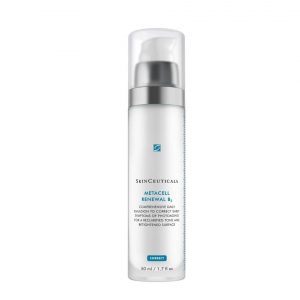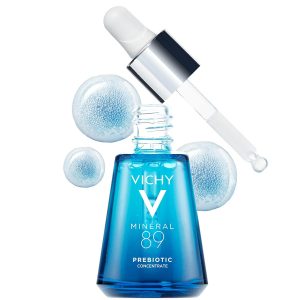What is niacinamide?
Nicotinamide, also known as niacinamide, is a form of vitamin B3, has emerged as a versatile ingredient in skincare, offering a multitude of benefits for various skin conditions. Renowned for its anti-inflammatory properties, nicotinamide soothes irritation and redness, making it a valuable asset for those battling acne, rosacea, or sensitive skin. Additionally, it regulates sebum production, helping to balance oily skin and prevent breakouts. Its ability to bolster the skin barrier function enhances moisture retention, making it an effective ally against dryness and premature aging. Furthermore, nicotinamide is prized for its capacity to fade hyperpigmentation and even out skin tone, lending a radiant complexion. This review article will focus on the science and data behind the use of niacinamide in anti-aging and hyperpigmentation.
The Science Behind Niacinamide
I was excited and surprised to discover that, unlike many of the ingredients out there in common skincare products, there is a good amount of data and evidence speaking to the efficacy of niacinamide. Let’s first focus on how it works and then we’ll dive deeper into the various study results. To provide a comprehensive overview, I will list all the potential benefits of niacinamide here as many of these effects compliment and add to each other. The clinical trial review will focus on only the anti-aging and hyperpigmentation components.
-
Anti-aging effect:
- Niacinamide helps make more collagen, which reduces wrinkles and smooths rough skin.
-
Lightening effect:
- Niacinamide can lighten dark spots by preventing the movement of pigment particles between skin cells.
-
Anti-inflammatory effects:
- Niacinamide reduces skin inflammation by blocking certain enzymes and controlling inflammatory substances in the skin.
-
Antimicrobial effect:
- Niacinamide stops the growth of some bacteria and viruses by interfering with their vital processes.
-
Barrier protective effect:
- Niacinamide strengthens the skin’s protective barrier by helping to create ceramides, which keep the skin hydrated and healthy.
-
Photoprotective effect:
- Niacinamide protects the skin from sun damage by restoring energy to skin cells and preventing overactivity of harmful enzymes.
-
Anti-itch effect:
- Niacinamide reduces itching by improving the skin barrier and preventing the release of itch-causing chemicals.
Clinical Efficacy Data For Niacinamide
As I mentioned previously, there are quite a few published clinical trials evaluating the efficacy and safety of niacinamide. Even more impressive is that many of these are double-blinded, randomized controlled trials, the gold standard in research! Those that I’m highlighting below focus on evaluating its effect on anti-aging and hyperpigmentation.
-
- This double-blinded, randomized controlled trial with ~140 patients found that a topical formulation containing 2% N-acetyl glucosamine and 4% nicotinamide significantly reduced the detectable area of facial spots and the appearance of pigmentation compared to a vehicle formulation.
-
- A study was conducted to compare the effects of 4% niacinamide cream and 4% hydroquinone (HQ) cream on melasma, a skin condition causing dark patches. Twenty-seven women with melasma applied niacinamide on one side of their face and HQ on the other for eight weeks, while also using sunscreen. Both treatments improved pigmentation, with 44% of patients showing good to excellent improvement with niacinamide and 55% with HQ. Niacinamide also reduced inflammation and sun-related skin damage. Side effects were less frequent with niacinamide (18%) compared to HQ (29%). The study concluded that niacinamide is a safe and effective treatment for melasma, offering similar benefits to HQ but with fewer side effects.
-
- This study aimed to further explored the benefits of using niacinamide on aging skin and skin yellowing. Fifty Caucasian women aged 40-60 participated in a 12-week study. They used two moisturizer products, one with 5% niacinamide and one without, on different sides of their faces. The results showed that niacinamide improved fine lines, wrinkles, hyperpigmentation spots, texture, and red blotchiness compared to the control. Interestingly, it also significantly reduced skin yellowing. The study suggests that niacinamide is well-tolerated and offers various skin benefits, possibly through multiple mechanisms.
-
- This was a follow-up study to the above and aimed to assess the effects of topical niacinamide on various skin properties beyond what was previously observed. They conducted a 12-week clinical trial involving 50 white female subjects with signs of facial aging. Half of each participant’s face received 5% niacinamide twice daily, while the other half received a control (no active ingredients). Results showed significant improvements in fine lines, wrinkles, hyperpigmented spots, red blotchiness, and skin yellowing in the niacinamide-treated areas compared to the control. Additionally, elasticity of the skin was improved. These findings suggest that topical niacinamide offers multiple benefits for aging skin, including improved appearance of wrinkles, reduced hyperpigmentation, and enhanced elasticity.
-
- In this study, researchers looked at how well a new skincare product with niacinamide worked for reducing wrinkles around the eyes. They tested it on 30 Japanese women over 8 weeks, comparing it to a product without niacinamide. They found that the niacinamide product significantly improved wrinkles for 64% of the participants compared to the control product. Skin texture also improved, with fewer wrinkles and smoother skin. Overall, the niacinamide lotion was well-tolerated, with only one person experiencing minimal irritation. These findings suggest that this lotion could be a good option for reducing eye wrinkles.
-
- For this study, researchers looked at how applying a mix of stem cell and niacinamide cream after laser treatment affects aging skin. They tested it on 25 people with aging skin who got laser treatment on both sides of their face. One side of their face got cream with stem cells and niacinamide, while the other side got regular cream. After three weeks, they found that the side with the special cream had fewer wrinkles and less dark spots. People also liked how their skin looked more on that side. Lab tests also showed that the special cream helped reduce inflammation and increase collagen, which is good for skin. This suggests that using this special cream after laser treatment might make your skin look younger.
-
- In another randomized, double-blind study, researchers researchers tested a cream containing niacinamide and N-acetyl glucosamine (NAG) on women aged 40-60 with facial dark spots. For 10 weeks, participants used either the niacinamide + NAG cream or a regular cream, both with SPF 15. The results showed that the niacinamide + NAG cream significantly reduced dark spots and pigmentation better than the regular cream, proving it to be more effective in treating uneven skin tone.
What to look for in an effective niacinamide product

When searching for a skincare product containing niacinamide for anti-aging and/or hyperpigmentation effects, here are several key factors to consider:
- Concentration of niacinamide: Look for products that contain a sufficient concentration of niacinamide. Studies have shown benefits with concentrations ranging from 5-20%.
- Formulation: Choose products with stable formulations that ensure the effectiveness of niacinamide. Avoid products with ingredients known to destabilize niacinamide, such as certain forms of vitamin C (e.g. combination products with niacinamide and ascorbic acid).
- Additional Active Ingredients: Some products combine niacinamide with other active ingredients like hyaluronic acid, ceramides, or peptides to enhance its anti-aging and brightening effects. Look for complementary ingredients that target specific skincare concerns you may have.
- pH Balance: Niacinamide works best at a slightly acidic pH, so opt for products formulated within the skin’s natural pH range (pH 4.5 to 5.5) to ensure optimal efficacy or those that specify their formulations designed to maintain skin’s natural pH balance.
- Product Type: Choose a product type that fits well with your skincare routine and preferences, whether it’s a serum, moisturizer, toner, or mask.
- Packaging: Opt for products packaged in opaque or tinted containers or airless pumps to protect the niacinamide from degradation due to light and air exposure.
- Compatibility: Niacinamide is generally well-tolerated by most skin types, including sensitive skin. However, it’s essential to check the ingredient list for any potential irritants or allergens, especially if you have sensitive skin or known allergies. Avoid products that contain ingredients like fragrances, dyes, or high concentrations of alcohol, which may cause irritation or sensitivity.
- Solvents: Niacinamide is water-soluble, so it’s typically formulated in water-based products like serums, lotions, and creams. Water-based formulations ensure optimal solubility and absorption of niacinamide into the skin.
- Stabilizers: While niacinamide is stable on its own, incorporating stabilizers like antioxidants (e.g., vitamin E, ferulic acid) can help protect it from degradation caused by exposure to light, air, and temperature fluctuations. These stabilizers can prolong the shelf life of niacinamide-containing products and maintain their efficacy over time.
Niacinamide Product Recommendations
For the products below, I selected those that are marketed for anti-aging and hyperpigmentation. I ranked them based on the following methodology:
- Key ingredient includes niacinamide and the strength (%) is listed
- Availability and performance of clinical study results (e.g. quantity of participants, duration, objective measure, results)
- Active co-ingredients
- Cost
*If you are pregnant and are considering using niacinamide, know that there are limited controlled animal or human studies on the effects of this ingredient on the fetus. This is pretty standard across many drugs whether they are prescription or non-prescription. The FDA does monitor safety of cosmetic products or ingredients, which includes whether there are likely to be safety concerns when women use the product during pregnancy. When they identify a safety problem, they do publish this information publicly. I was unable to find any public information on niacinamide on their website.
|
Product |
Niacinamide Strength (%) |
Active Co-Ingredients |
Highlights |
|
Neutrogena Hydro Boost+ Niacinamide Unscented Face Serum
|
10% |
Hyaluronic Acid, Glycerin |
Large clinical study of subject at home which showed improved skin clarity and tone; fragrance-free |
|
La Roche-Posay MELA B3 Dark Spot Serum with Melasyl™
|
10% |
Melasyl™, Hyaluronic Acid |
Moderate size study over 10 weeks with subjects seeing visibly reduces dark spots. Melasyl is an undisclosed trademark ingredients with claims to help reduce hyperpigmentation |
|
The Ordinary Niacinamide 10% + Zinc 1%
|
10% |
Zinc PCA |
Small clinical study reporting subjects had improved skin radiance, luminosity, and hydration but did not specified how many patients showed improvements; fragrance free |
|
COSRX The Niacinamide 15 Serum
|
15% |
N-Acetylglucosamine, Zinc PCA, Allantoin |
Small study reporting about 15-20% improvements in improvement of hyperpigmentation |
|
SkinCeuticals Metacell Renewal B3
|
5% |
Peptides, Glycerin |
Moderate size, dermatologist led with subjects showing minor to moderately improved radiance, fine lines, and firmness |
|
Naturium Niacinamide Face Serum 12% + Zinc 2%, Skin Complexion Treatment & Pore Minimizer, with Hyaluronic Acid & Vit E
|
12% |
Zinc, Hyaluronic acid, Vitamin E |
Small study showing the majority of users reported improvement in pore size, fine lines and wrinkles and dark spots |
|
Glow Recipe Watermelon Glow Niacinamide Dew Drops Serum
|
Not specified |
Hyaluronic Acid |
Small consumer studies over 4 weeks with subjects reporting improved glow, brightness, and hydration |
|
Paula’s Choice Niacinamide 20% Treatment
|
20% |
Acetyl Glucosamine, Purslane, Camellia Japonica Flower Extract, Epigallocatechin Gallate, Ascorbyl Glucoside |
Small consumer studies where the majority of users reported improved pore size and younger looking skin |
|
Sunday Riley B3 Nice 10% Niacinamide Serum
|
10% |
Brightenyl, Trans-Resveratrol, Botanical Extracts |
8 weeks consumer study with unspecified participant size; expert grading and consumer reported reduction in dark spots, oiliness, redness, and pore size; improvement in wrinkles |
|
Vichy Mineral 89 Niacinamide Serum, Skin Strengthening Prebiotic Concentrate and Anti-Aging Face Serum for Brightening and Fine Lines
|
Not specified |
Hyaluronic Acid, glycerin |
Moderate size trial with moderate reports of enhanced radiance, improved texture, reduced fine lines; Niacinamide strength not specified; fragrance-free, non-comodogenic |
As an Amazon affiliate, I may earn compensation from qualifying purchases.














